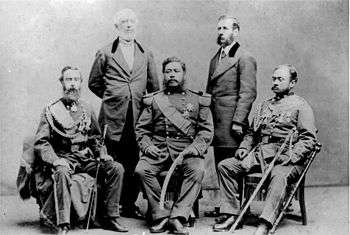Reciprocity Treaty of 1875

The Treaty of reciprocity between the United States of America and the Hawaiian Kingdom (Hawaiian: Kuʻikahi Pānaʻi Like) was a free trade agreement signed and ratified in 1875 that is generally known as the Reciprocity Treaty of 1875.
The treaty gave free access to the United States market for sugar and other products grown in the Kingdom of Hawaii starting in September 1876. In return, the US gained lands in the area known as Puʻu Loa for what became known as the Pearl Harbor naval base. The treaty led to large investment by Americans in sugarcane plantations in Hawaii. The treaty was signed on January 30, 1875, ratified by the Kingdom of Hawaii April 17, 1875 and ratified by the United States on May 31, 1875.[1] Negotiators were Henry A. P. Carter, Minister to the US Elisha Hunt Allen, Minister of Foreign Affairs William Lowthian Green, and King Kalākaua for the Kingdom of Hawaii.[2] For the US, signers were Secretary of State Hamilton Fish and president Ulysses S. Grant.[1]
The first shipment of sugar from Hawaii to the United States under the treaty arrived in San Francisco in September 1876 in a ship commanded by Captain William H. Marston.
See also
- Honolulu Courthouse Riot
- Early History of Pearl Harbor
- List of bilateral treaties signed by the Kingdom of Hawaii
References
- 1 2 "Text of the treaty". The Morgan Report web site. Retrieved 2009-10-02.
- ↑ George F. Nellist, ed. (1925). "Green, William Lowthian". The Story of Hawaii and Its Builders. Honolulu Star Bulletin. Retrieved July 30, 2010.
